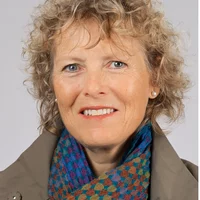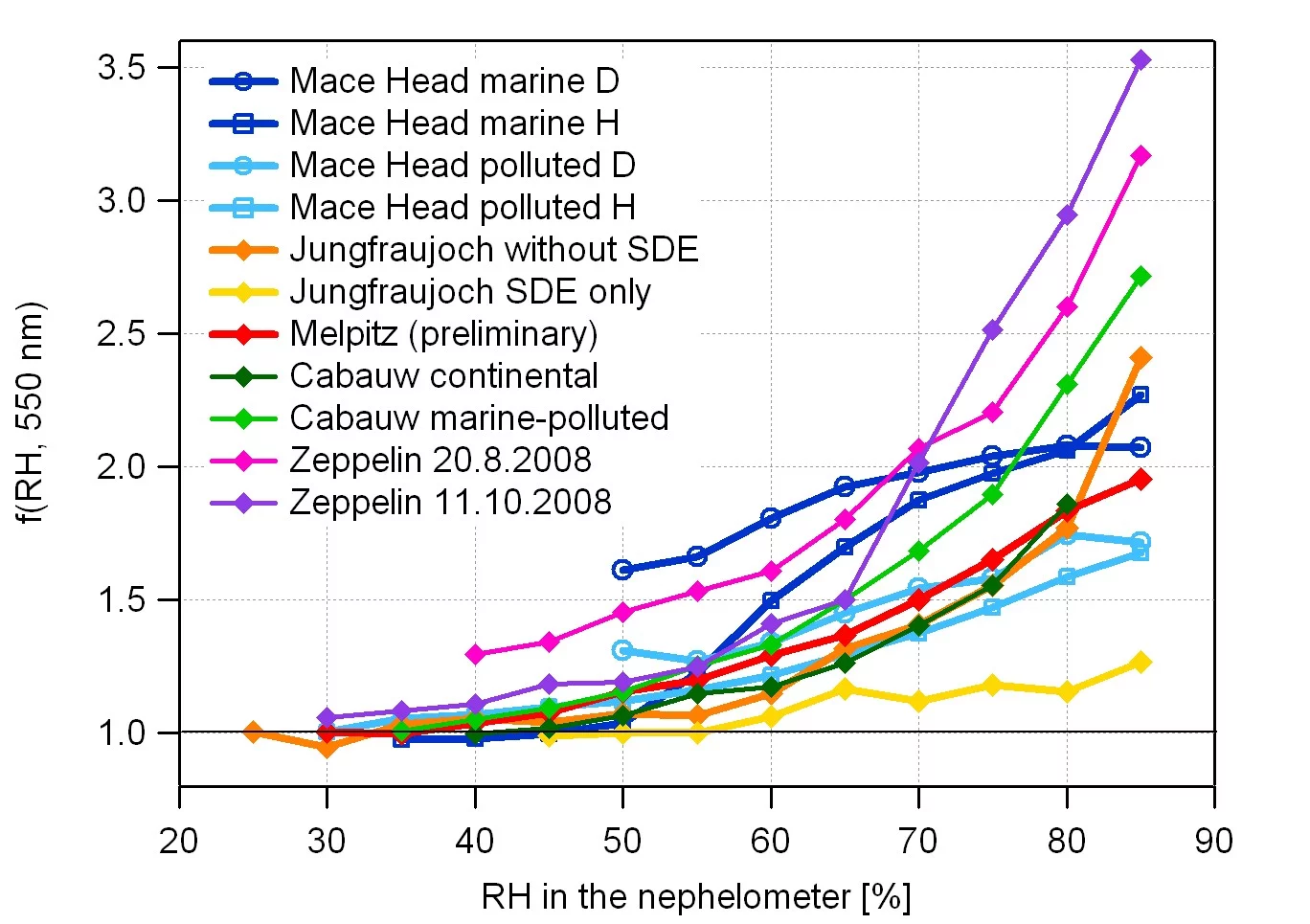EUSAAR (European Supersites for Atmospheric Aerosol Research) is an EU-funded I3 (Integrated Infrastructures Initiatives) project carried out in the framework of the specific research and technological development programme "Structuring the European Research Area - Support for Research Infrastructures".
Scope of project
The objective of EUSAAR is the integration of measurements of atmospheric aerosol properties performed in a distributed network of 20 high quality European ground-based stations. This integration contributes to a sustainable reliable operational service in support of policy issues on air quality, long-range transport of pollutants and climate change.
Within this project we performed continuous measurements of a wide variety of aerosol variables at the Jungfraujoch. These data are regularly submitted to the EUSAAR data base. On-line visualization of the Jungfraujoch data is provided here.
Within the project we also build a new generation of standard, cost-effective humidity-controlled aerosol monitors for long-term monitoring activities, i.e.
Within this project we performed continuous measurements of a wide variety of aerosol variables at the Jungfraujoch. These data are regularly submitted to the EUSAAR data base. On-line visualization of the Jungfraujoch data is provided here.
Within the project we also build a new generation of standard, cost-effective humidity-controlled aerosol monitors for long-term monitoring activities, i.e.
- Hygroscopicity Tandem Differential Mobility Analyzer (HTDMA)
- Humidity controlled nephelometer
Results from the HTDMA measurements at Jungfraujoch:
Efforts were undertaken to get HTDMA instruments ready for long-term measurements and to establish quality assurance standards [Duplissy et al., 2009]. Within this project a 13-month climatology of the aerosol hygroscopicity from the Jungfraujoch was obtained [Kammermann et al., 2010]. This dataset was complemented with continuous size distribution and CCN data [Jurányi et al., 2011]. The annual cycle of the hygroscopic growth factor (GF) at Jungfraujoch showed no clear annual trend. GFs increased only little with increasing diameter. The fact that the hygroscopicity remains stable shows that the chemical composition of the aged aerosol at Jungfraujoch is fairly constant through out the year. This allowed us to reliably predict the number concentration of CCN from particle number size distribution data [Jurányi et al., 2011].
Results obtained with the humidity controlled nephelometer:
We conducted intensive field measurements with a newly developed humidity controlled nephelometer. This instrument is able to measure the hygroscopic aerosol behavior and hysteresis effects. Using a second nephelometer measuring under dry conditions the so-called light scattering enhancement factor f(RH), defined as the ratio of the humidified and dry scattering coefficients, was determined. Intensive measurement campaign were conducted at
- Black forest, Germany [Fierz-Schmidhauser et al., 2010a]
- Jungfraujoch, Switzerland [Fierz-Schmidhauser et al., 2010b]
- Ny Alesund, Zeppelin station, Spitsbergen, Norway [Zieger et al., 2010]
- Mace Head, Ireland [Fierz-Schmidhauser et al., 2010c]
- Cabauw, The Netherlands [Zieger et al., 2011]
- Melpitz, Germany
Publications
Journal Articles
Duplissy, J., M. Gysel, S. Sjogren, N. Meyer, N. Good, L. Kammermann, V. Michaud, R. Weigel, S. M. d. Santos, C. Gruening, P. Villani, P. Laj, K. Sellegri, A. Metzger, G. B. McFiggans, G. Wehrle, R. Richter, J. Dommen, Z. Ristovski, U. Baltensperger, and E. Weingartner (2009), Intercomparison study of six HTDMAs: results and recommendations, Atmospheric Measurement Techniques, 2, 363-378.Fierz-Schmidhauser, R., P. Zieger, G. Wehre, A. Jefferson, J. A. Ogren, U. Baltensperger, and E. Weingartner (2010a), Measurement of relative humidity dependent light scattering of aerosols, Atmospheric Measurement Techniques, 3, 39-50.
Fierz-Schmidhauser, R., P. Zieger, M. Gysel, L. Kammermann, P. F. DeCarlo, U. Baltensperger, and E. Weingartner (2010b), Measured and predicted aerosol light scattering enhancement factors at the high alpine site Jungfraujoch, Atmos. Chem. Phys., 10(5), 2319-2333.
Fierz-Schmidhauser, R., P. Zieger, A. Vaishya, C. Monahan, J. Bialek, C. D. O'Dowd, S. G. Jennings, U. Baltensperger, and E. Weingartner (2010c), Light scattering enhancement factors in the marine boundary layer (Mace Head, Ireland), J. Geophys. Res., 115, D20204, doi:20210.21029/22009JD013755.
Jurányi, Z., M. Gysel, E. Weingartner, P. F. DeCarlo, L. Kammermann, and U. Baltensperger (2010), Measured and modelled cloud condensation nuclei concentration at the high alpine site Jungfraujoch, Atmos. Chem. Phys., 10, 7891-7906, doi: 7810.5194/acp-7810-7891-2010
Jurányi, Z., M. Gysel, E. Weingartner, N. Bukowiecki, L. Kammermann, and U. Baltensperger (2011), 17-month climatology of the cloud condensation nuclei number concentration at the high alpine site Jungfraujoch, J. Geophys. Res., 116(D10204), doi:10.1029/2010JD015199.
Kammermann, L., M. Gysel, E. Weingartner, and U. Baltensperger (2010), 13-month climatology of the aerosol hygroscopicity at the free tropospheric site Jungfraujoch (3580 m a.s.l.), Atmos. Chem. Phys., 10, 10717-10732.
Zieger, P., R. Fierz-Schmidhauser, M. Gysel, J. Strom, S. Henne, K. E. Yttri, U. Baltensperger, and E. Weingartner (2010), Effects of relative humidity on aerosol light scattering in the Arctic, Atmos. Chem. Phys., 10(8), 3875-3890.
Zieger, P., E. Weingartner, J. Henzing, M. Moerman, G. d. Leeuw, J. Mikkilä, M. Ehn, T. Petäjä, K. Clémer, M. v. Roozendael, S. Yilmaz, U. Frieß, H. Irie, T. Wagner, R. Shaiganfar, S. Beirle, A. Apituley, K. Wilson, and U. Baltensperger (2011), Comparison of ambient aerosol extinction coefficients obtained from in-situ, MAX-DOAS and LIDAR measurements at Cabauw, Atmos. Chem. Phys., 11, 2603-2624.
Thesis
Zieger, P. (2011), Effects of relative humidity on aerosol light scattering, ETH Zürich, Nr. 19659, Zürich.Fierz-Schmidhauser, R. (2010), Enhancement of the light scattering coefficient of atmospheric aerosol particles by water uptake, ETH Zürich, Nr. 18784, Zürich.


